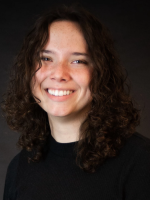Baylor, 10, prefers to sing and dance everywhere she goes. She loves learning TikTok trends, playing basketball and hates summer break because it means she is away from her friends at school.
Baylor is also immunocompromised. She was diagnosed with acute liver failure at one and a half years old and received a transplant not long after. She takes immunosuppressant medication to prevent rejection and is unable to get certain vaccines, like her remaining MMR and chickenpox doses, because they use a weakened form of the germ that causes a disease.
Her mom, Alyssa Andrews, said navigating life as a transplant family has been hard for her social butterfly, who had to be a virtual student for over two years during the COVID-19 pandemic.
“I just remember sending my son to school one year, and she was crying because she wanted to go,” Andrews said, “And she made a statement and was like, ‘I just know that my best friend is there waiting on me, and I want to go to school so bad.’”
Like many immunocompromised students, Baylor relies on herd immunity, where enough people are protected against certain diseases to limit their spread. But according to CDC data, vaccination coverage is continuing to decline to levels that could increase the risk of outbreaks.

During the previous school year, 5.7% of Oklahoma kindergarteners obtained an exemption for one or more vaccines. Although this rate didn’t change from the 2023-2024 school year, it’s still significantly higher than the national rate of 3.6%. This data also comes as preventable diseases like measles and whooping cough have seen record spreads nationally.
Oklahoma officials are working to navigate this landscape as the school year begins by bridging the gap between public health information and patients, providing resources and working to ensure students can comfortably attend school.
What does the data say?
Oklahoma offers medical exemptions for vaccines and is one of 14 states that allow them for either religious or personal reasons. Those objections have contributed significantly to climbing exemption rates, with medical exemptions sitting below .5% since the 2011-2012 school year.
Data from the previous school year notes that Oklahoma kindergartners’ coverage has also varied among different vaccines. For example, students have better coverage levels for vaccines that help prevent chicken pox and Hepatitis B at around 94%. But coverage for the MMR vaccine, which protects against measles, mumps and rubella, is sitting around 88.7%.
Herd immunity against measles requires about 95% of a population to be vaccinated. The CDC notes vaccine exemptions above 5% can increase the risk of outbreaks of preventable diseases.
Oklahoma has seen impacts from a resurgence of childhood diseases in the U.S. Overall, measles has sickened more people this year than in previous years since it was declared eliminated in 2000. The state has reported 20 measles cases, and most were among unvaccinated individuals.
Oklahoma has also seen a significant amount of whooping cough cases, with 469 reported last year compared to 20 in 2023. Hundreds more have been reported so far this year.

Why are families opting their children out?
What is causing parents to opt their children out of vaccines? Jennifer Reich, a professor of sociology at the University of Colorado Denver, said the answer isn’t categorical.
Reich wrote a book called “Calling the Shots: Why Parents Reject Vaccines,” which explores the attitudes and beliefs of parents who choose not to immunize their children. Reich said many of the families she speaks with talk about having a different strategy for each child in their family.
When it comes to vaccine hesitancy, many parents aren’t fully rejecting vaccines, Reich said. Some are delaying them and coming up with different schedules. But others are “vaccine refusers” who are “largely unpersuadable and intend to be hardliners,” she said. Though she said the population is “numerically small.”
The decision to opt out of vaccines is often a logical consequence of current cultural values, Reich said, which say that being a good parent means doing your own research and, if your child gets sick, it’s an individual failure. Conversations have also become increasingly polarized and partisan post-COVID, fueled by the repetition of misinformation, she said.
She said it’s unsurprising that parents walk into appointments to talk about vaccines and feel uncertain.
“To have vaccines be the one place where health care providers, for example, suggest you just trust the system, whereas everything else has been about agonizing choices, [it] doesn't really make a lot of sense,” Reich said.
But, when parents don’t think about vaccines as part of a collective strategy, Reich said there can be consequences.
“We don't have a lot of conversations about how to make sure everyone's children are safe, but rather we've really left it to individual parents to be solely responsible for their children's outcomes,” Reich said. “And we just know that that's not gonna work well for all families, and it means some children are gonna be harmed by that.”

Andrews said her daughter’s school in Choctaw communicates with them – especially during times of increased risk like flu season – to ensure they are aware when kids are out sick. But seeing a rise in vaccine hesitancy and disease can be worrisome as a mom of an immunocompromised child.
“She does a really good job of identifying things from her [fellow] students that she doesn't feel comfortable with, as far as people being sick. And obviously you can't necessarily tell who's vaccinated or not,” Andrews said. “But you can only be proactive in so many ways.”
How are schools responding?
This year, Oklahoma City Public Schools implemented a new policy, requiring students to be up to date or exempted before school starts. Previously, students could attend school if they were in the process of receiving their vaccines.
Anika Starling, the district’s director of health services, said the change was driven by data.
“Data is our driving force in everything that we do here in the district, whether it's academically or whether we're talking about health,” Starling said. “And I think it was just us saying, ‘We need to do this, because it's the right thing to do.’”
An OKCPS spokesperson said in an email the district is currently allowing a temporary grace period for families to submit their student’s vaccination records or file an exemption “due to vaccination supply issues.”
The district partnered with Oklahoma Children’s Hospital OU Health to host extended walk-in vaccination hours. There were 240 patients seen between four clinics for after-hours vaccinations, according to an OU Health spokesperson.
Starling also said partners like the Oklahoma City-County Health Department and the Oklahoma Caring Van Program set up additional times to support families. The goal is to meet families where they are.
“Whether south side or north side, east or west – we still have that strong band of partnerships, so if they need to get off work, take their child, they have that flexibility,” Starling said. “So we're building that in for our families.”

Dr. Catherine Mims, a pediatrician and internist at OU Health, said she’s seen the impacts of disease spread in her patients, particularly with record-high hospitalizations and outpatient visits for influenza. She said the hospital hopes to lead the charge in providing education surrounding vaccines and opportunities to get them.
“What we know is that vaccines are one of the greatest public health improvements in the last 50 years,” Mims said. “And so in an effort to sort of combat the new measles outbreak, the whooping cough outbreak that we've seen over the last year, and then certainly flu last year was a really bad season for it. We're hoping to combat some of that by getting as many kids vaccinated as possible.”
A collective strategy
As the 2025-2026 school year kicks off, Dr. Steven Crawford said he is hoping vaccination rates will improve. Crawford is the chair of the board of the Oklahoma Alliance for Healthy Families – a “small but mighty” alliance whose goal is to educate the public on the value of science-based health care decisions.
This year, the alliance worked with the Oklahoma State Medical Association and Oklahoma Children's Hospital OU Health to develop a measles-related toolkit for school officials. Crawford said he thinks people are hungry for information right now, and the organizations wanted to serve as a resource.
“We wanted to provide a seasoned and a rational choice of appropriate information, rather than inappropriate, when they were seeking that information and we thought what better way to do it than through the schools – a trusted source of information for most people,” Crawford said.
His main concern is resistance at the federal level. He cited, for example, the American Academy of Pediatrics’ recent decision to release its own vaccine recommendations, breaking with federal guidance. It includes updated recommendations for RSV, influenza and COVID-19 immunizations for pediatric populations.
“The challenge there is that even though we have the measles outbreak that heightens [people's] belief in vaccine-preventable immunization efforts, we have a negative consequence of what's happening at the federal level that's caused people to be confused at least, if not doubtful of vaccine advocacy,” Crawford said.

Reich said, in talking with families, she found very few believed their decisions were settled. She said provider-to-patient education and counseling are valuable and should be better incentivized.
She also said the conversation could benefit from focusing more on the impact vaccines can have on communities as a whole.
“We saw huge amounts of generosity during COVID of people taking care of the people in their community who are vulnerable. But we haven’t yet really talked about vaccines in those terms. And I think that's a mistake,” Reich said. “I think making that clearer to people might just give them a different way to think about their participation.”
Andrews said when she moved to Oklahoma, she learned about the “Oklahoma Standard.” It was born out of the response to the Oklahoma City bombing and means neighbors are responsible for helping one another.
“I wish we could kind of change the narrative from just overcoming tragedy to more of a preventive measure,” Andrews said. "Let's have the Oklahoma Standard be protecting our communities.”
StateImpact Oklahoma is a partnership of Oklahoma’s public radio stations which relies on contributions from readers and listeners to fulfill its mission of public service to Oklahoma and beyond. Donate online.







